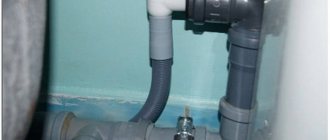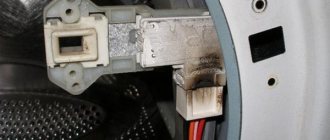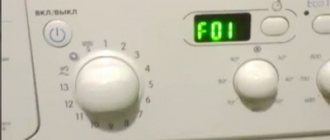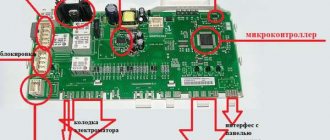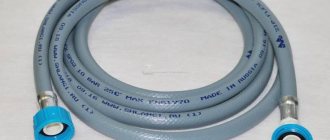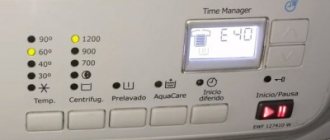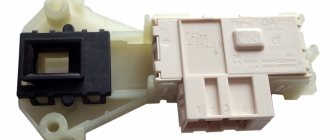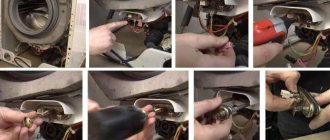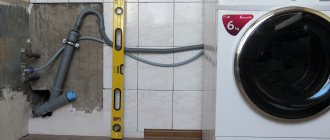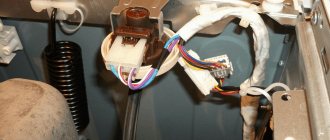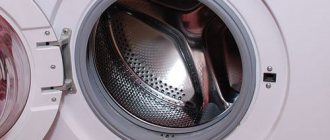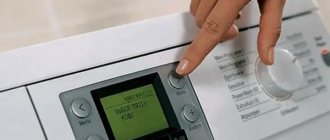In some situations, it is cheaper to purchase a new product than to restore broken household appliances. However, a prudent person will receive additional benefits by using functional components for their intended purpose. This publication presents homemade products from a washing machine engine. Using the recommendations of the editors of Seti.guru, you can create unique things with your own hands. And video clips will help you more accurately reproduce the craftsmen’s homemade products and get useful products quickly and at no extra cost.
You can “revive” the robot using a washing machine engine
What is a motor from an old washing machine good for?
First, it is necessary to clarify the real capabilities of the existing power unit. In household appliances of the Soviet period, fairly reliable asynchronous electric motors (180−220 W) were installed. They were connected to two-phase AC networks. Previously, structures were created in a collapsible design. Therefore, in the event of a breakdown, repairs do not cause excessive difficulties. The only exception is damage to the windings. Modern models have increased power (up to 340 W).
Asynchronous electric motor
Since the late 90s of the last century, such simple engines have not been used. Instead of asynchronous ones, collector units are more often used. They are more compact and weigh less. The corresponding modifications provide the following capabilities:
- DC power connections;
- smooth speed control.
To supply current to the rotor part, graphite rods with spring pushers are used. These parts must be replaced periodically. The power of commutator-type electric motors ranges from 340 to 780 W at a working shaft rotation speed in the range of 11400−15200 rpm.
Brushless motor
The photo shows a power unit that was first used by engineers of the famous South Korean brand LG. It is often called inverter, since it is assumed that the speed can be smoothly adjusted (up to 2 thousand per minute) using an external control device. The power of such units exceeds 500 W, which allows it to be connected directly to the drum shaft without a special belt drive. The following parameters and features of the motor from an automatic washing machine determine where this power unit can be used:
- power;
- speed of rotation of the working shaft;
- dimensions;
- weight;
- power supply and control circuit.
For your information! More attentive people pay attention to maintainability, reliability, and resistance to external influences. They study the opinions of experts in specialized forums, and official guarantees of manufacturers.
What can you collect?
Much depends on the type and class of electric motor, which will become your starting point for ideas.
If this is a motor from an old model, produced back in the USSR, then it is probably an asynchronous type , with two phases, although not particularly powerful, but reliable. Such a motor can be adapted for many homemade products that will find use in everyday life.
Another type of motor from old “washers” is a commutator motor. These motors can operate on both direct and alternating current. Quite fast models that can accelerate to 15 thousand rpm. The speed can be adjusted with additional devices.
The third type of motor is called direct brushless. This is a modern group of electric drives that do not have any standard for their equipment. But their classes are standard.
Motors also come with either one or two speeds. These options have a strict speed characteristic: 350 and 2800 rpm.
Modern inverter motors are rarely found in scrap metal dumps, but there are quite promising plans for them among those who like to make something very useful for the family, and even with electronic control.
Here is an incomplete list of devices that you can easily build with your own hands based on a working electric motor from a washing machine:
- generator;
- sharpener (emery);
- milling machine;
- drilling machine;
- feed cutter;
- electric bike;
- concrete mixer;
- electric saw;
- hood;
- compressor.
What can be made from an old washing machine: examples of work with comments
The information below will help you implement various projects based on the corresponding power unit. Here are working homemade products from a washing machine motor, which performed well during practical tests. Some projects include step-by-step instructions with detailed explanations of the assembly process.
How to make a grinder or sharpener from a washing machine engine
| Illustration | Description of action |
| First of all, let's determine which replacement nozzles will be used in practice. The features of the processing processes are of significant importance: the duration of cycles, the hardness of the workpiece material, etc. | |
| In this embodiment, the author uses grinding discs with a diameter of 200 mm with an adhesive layer on the non-working side. He selected a grinder nozzle of approximately the same size (175 mm) with a threaded connection in the central part. | |
| To implement the plans, an old washing machine motor was found, which rotates the armature at a speed of up to 1500 rpm. In the photo, the arrow marks the starting relay mounted on the housing. Power supply: AC 220 V. | |
| A special attachment was created on a lathe. It is attached to the 14mm shaft with a screw. A rod with a thread is welded to the end of the part, which corresponds to the connecting node of the adapter. | |
| During practical testing, it became clear that the initial rotation did not correspond to the thread direction. This means that when performing work operations the nozzle will unscrew. The author did not use a special electrical circuit, but swapped the housing covers along with the bearing. | |
| To securely fasten the power unit, a special frame is created from steel corners. Welded joints have been cleaned. At the final stage, the product is coated successively with a metal primer and paint. | |
| Using screws, a table (1) equipped with a rotating frame is connected to the frame. A support rod (2) with height adjustment is installed in the center. With its help, the exact angle required for working with workpieces is established. | |
| The assembly confirmed the accuracy of the calculations and individual parts. To eliminate errors, you need to prepare a set of drawings in advance. It is not necessary to comply with engineering GOSTs. However, you need to carefully understand the features of each design component, note the dimensions and mounting dimensions. | |
| Practical testing shows the good functionality of the new machine. The power is quite sufficient for processing duralumin blanks. An additional plus is the quiet operation of the washing machine motor. | |
| To collect and remove waste, a special box is made with an outlet pipe for connecting a vacuum cleaner. It is installed at the bottom of the frame under the working area. |
For your information! Using this algorithm, it is easy to create a high-quality sharpening machine from a washing machine. To increase safety, personal protective equipment should be used during processing. A transparent polymer shield covering the work area is also useful.
Wood lathe
It is not too difficult to create a sharpener with your own hands from a washing machine. However, the following example demonstrates the relative ease of manufacturing more complex equipment.
Main functional components are mounted on a metal frame to increase durability
Thick walls (5mm) and high-quality welded joints ensure structural integrity under heavy loads
According to this electrical diagram, a connection to a 220 V network is made
Since an asynchronous motor from the Vyatka washing machine is used, a capacitor is installed in the power circuit. The armature of this power unit rotates at a speed of 400/3000 revolutions per minute. To install the axle parallel to the frame parts, washers of appropriate thickness were selected.
The headstock is made of thick plywood (22 mm) with tapered studs
The design of the tailstock is clear from this photo
With this photo the author confirms the functionality of his technological equipment
Lawnmower
Where can you use the motor from a washing machine - this technique will simplify the task of creating an ideal lawn.
The picture shows important nuances:
- These rods (1) must have sufficient strength, since the movement of equipment around the site is carried out manually.
- The motor switch for the washing machine is installed near the handle for user convenience. For connection, use wire (2) with high-quality insulation. Provide good sealing of electrical components so as not to create emergency situations in conditions of high humidity.
- Belt drive (3) reduces vibration levels. By changing the size of the pulleys, the optimal rotation speed of the knives is selected.
- Such units (4) are used to adjust the clearance and mowing height of the lawn.
- Large wheels (5) are useful for overcoming obstacles on the land.
Feed cutter
Using a similar scheme, you can make a juicer or feed cutter from a washing machine engine.
This drawing will be useful for creating an effective shredder
How to turn an old washing machine engine into a generator
When the washing machine motor rotates, it produces electrical energy.
However, special preparation is required to obtain this result. A recess is made at the end of the rotor. Permanent magnets are fixed in it. The upgraded part is installed in place. To accumulate the received energy, a rectifier and a battery are used. These units are connected via a controller to optimize the charging process.
Rotor with neodymium magnets
Concrete mixer
To move a heavy working container, appropriate drives are used.
Here, two belt drives are supplemented with a gearbox. The complex managed to create the necessary torque with a relatively low power of the electric drive.
A circular saw
In this machine it is necessary to create high tool speeds.
To solve the problem, the author of the project installed a belt drive with a large and smaller pulley. Schemes with fastening a circular saw directly to the armature shaft are also used.
What can be made from a washing machine drum: simple designs
In practice, not only the motor from the washing machine will be useful. What can be made from a drum is described in the following sections of the publication.
Brazier from a drum from a washing machine: photos and useful tips
Minimal additions are needed to create this practical tool.
The stainless steel grill looks great. It retains its functional characteristics and impeccable appearance for a long time. It is easy to clean it from dirt. There are no sharp corners or other potentially dangerous parts. Resistance to high temperatures will come in handy. Light weight means no difficulty in moving. The most suitable workpiece is a drum from a top-loading washing machine. It has special doors that close the firebox and regulate the air flow.
Can you make a smokehouse from a washing machine drum?
For processing, meat, fish and other food products are placed for a long time in a closed container, where a high concentration of smoke is maintained. Low and high temperature technology is used. In any case, a good seal will come in handy.
The tank of an activator type washing machine with vertical loading is suitable.
Weld all extra holes. Install a pipe for supplying smoke. Lattice shelves and hangers for placing products are installed inside.
To create a similar container from a standard drum, you will have to close the holes in the wall
Decorative and functional crafts from a washing machine drum
These pictures show examples of products that can be created quickly and efficiently without detailed instructions:
Poufs
Illuminated coffee table and floor lamp
Bedside table and original decoration of the land
Homemade products from a washing machine engine: conclusions and additional information
In any case, even when working with a relatively simple design, design documentation should be prepared. This will simplify the search for additional components and prevent errors during assembly. Use the comments to post your own ideas and get answers to additional questions. With the help of our online magazine, it is easy to draw the right conclusion about what to do with your old washing machine after completing the intended use of the equipment.
The video demonstrates the operating principle and features of the feather removal machine:
Wood lathe
What can be made from an old washing machine? For example, a lathe; for the basis of a homemade lathe, it is good to use an asynchronous motor with two adjustable speeds. The main thing in the device is to make a stable base. The frame is usually made of profiles and metal corners.
The supporting structure and the motor axis must be parallel. Processing wood requires precision and accuracy, which will be impossible if the base is poorly secured.
There is no need to rush when disassembling an old washing machine. Each part should be carefully removed so as not to damage its integrity.
With prolonged contact with water, scale accumulates on the surface. It is dissolved using special means or removed mechanically.
In addition to the motor, a drum, loading hatch, housing, counterweights and springs are suitable for making homemade devices.
The engine will become the basis for a lathe or concrete mixer, and the hatch can replace an ordinary window in a room decorated in a non-standard style. And this is not all that can be done from an old washing machine.
